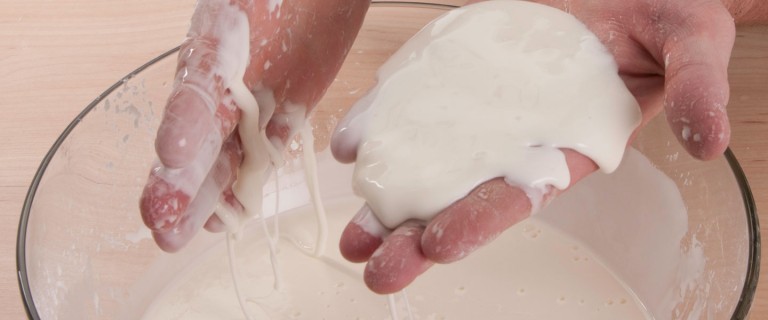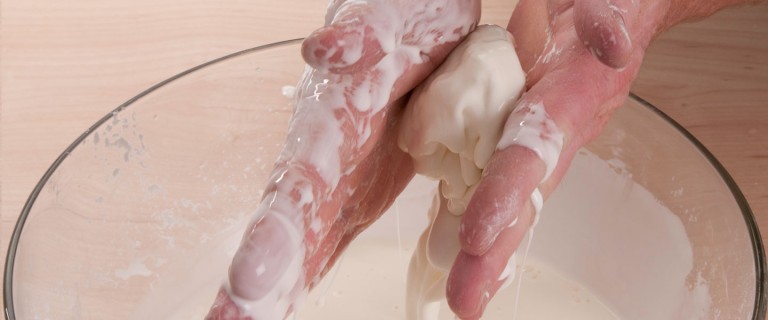Cornstarch Science
EXPERIMENT

1
1
Pour approximately one-quarter of the box (about 4 ounces) of cornstarch into the mixing bowl and slowly add about 1/2 cup of water. Stir. Sometimes it is easier (and more fun!) to mix the cornstarch and water with your bare hands.

2
Continue adding cornstarch and water in small amounts until you get a mixture that has the consistency of honey. It may take a little work to get the consistency just right, but you will eventually end up mixing one box of cornstarch with roughly 1 to 2 cups of water. As a general rule of thumb, you’re looking for a mixture of roughly ten parts cornstarch to one part water. Notice that the mixture gets thicker, or more viscous, as you add more cornstarch.

3
Sink your hand into the bowl of “quicksand” and notice its unusual consistency. Compare what it feels like to move your hand around slowly and then very quickly. You can’t move your hand around very fast. In fact, the faster you thrash around, the more like a solid the gooey stuff becomes. Sink your entire hand into the goo and try to grab the fluid and pull it up. That’s the sensation of sinking in quicksand!

4
Drop a plastic toy animal into the cornstarch mixture and then try to get it out. It’s pretty tough even for an experienced quicksand mixologist.
HOW DOES IT WORK
The cornstarch and water mixture acts like a solid sometimes and a liquid at other times. This concoction is an example of a suspension (a mixture of two substances), one of which is finely divided and dispersed in the other. In the case of the cornstarch quicksand, it’s a solid dispersed in a liquid.
When you slap the cornstarch quicksand, you force the long starch molecules closer together. The impact of this force traps the water between the starch chains to form a semirigid structure. When the pressure is released, the corn- starch flows again.
All fluids have a property known as viscosity—the measurable thickness or resistance to flow in a fluid. Honey and ketchup are liquids that have a high resistance to flow, or a high viscosity. Water has a low viscosity. Sir Isaac Newton said that viscosity is a function of temperature. So, if you heat honey, the viscosity is less than that of cold honey. The cornstarch-water mixture, and real quicksand, are both examples of non-Newtonian fluids because their viscosity changes when stress or a force is applied, not when heat is applied.
What is quicksand, really? Quicksand is nothing more than a soupy mixture of sand and water, where the sand is literally floating on water. Quicksand is just solid ground that has been liquefied by too much water, and the term “quick” refers to how easily the sand shifts in this solid-liquid state. Quicksand is created when water floods or saturates an area of loose sand and the sand begins to move around. When the water in the sandy soil cannot escape, it creates a liquid-like soil that can no longer support any weight. If an exces- sive amount of water flows through the sand, it forces the sand particles apart. This separation of particles causes the ground to loosen, and any weight placed on the sand will begin to sink through it.
The quicksand phenomenon can be caused by flowing underground water rising to the surface or even an earthquake that agitates the sand. You are likely to find quicksand around riverbanks, lake shorelines, marshes, beaches, near underground springs or any place where an uprising of water oversaturates and agitates the sand.
The next time you are standing barefoot on the beach, think about the properties of quicksand. Normally, the grains of wet sand are compressed together tightly and this firm ground easily supports your weight. The friction between grains of wet sand is strong enough to make it easy to build sand castles. However, when the sand on the beach is flooded with an excess amount of water, the agitated sand particles begin to move, separate, and quickly wash away right out from under your feet.
When you slap the cornstarch quicksand, you force the long starch molecules closer together. The impact of this force traps the water between the starch chains to form a semirigid structure. When the pressure is released, the corn- starch flows again.
All fluids have a property known as viscosity—the measurable thickness or resistance to flow in a fluid. Honey and ketchup are liquids that have a high resistance to flow, or a high viscosity. Water has a low viscosity. Sir Isaac Newton said that viscosity is a function of temperature. So, if you heat honey, the viscosity is less than that of cold honey. The cornstarch-water mixture, and real quicksand, are both examples of non-Newtonian fluids because their viscosity changes when stress or a force is applied, not when heat is applied.
What is quicksand, really? Quicksand is nothing more than a soupy mixture of sand and water, where the sand is literally floating on water. Quicksand is just solid ground that has been liquefied by too much water, and the term “quick” refers to how easily the sand shifts in this solid-liquid state. Quicksand is created when water floods or saturates an area of loose sand and the sand begins to move around. When the water in the sandy soil cannot escape, it creates a liquid-like soil that can no longer support any weight. If an exces- sive amount of water flows through the sand, it forces the sand particles apart. This separation of particles causes the ground to loosen, and any weight placed on the sand will begin to sink through it.
The quicksand phenomenon can be caused by flowing underground water rising to the surface or even an earthquake that agitates the sand. You are likely to find quicksand around riverbanks, lake shorelines, marshes, beaches, near underground springs or any place where an uprising of water oversaturates and agitates the sand.
The next time you are standing barefoot on the beach, think about the properties of quicksand. Normally, the grains of wet sand are compressed together tightly and this firm ground easily supports your weight. The friction between grains of wet sand is strong enough to make it easy to build sand castles. However, when the sand on the beach is flooded with an excess amount of water, the agitated sand particles begin to move, separate, and quickly wash away right out from under your feet.

Comments
Post a Comment